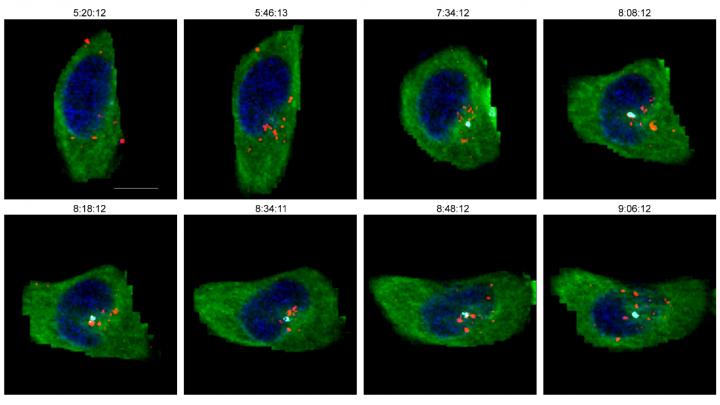
Credit: ©Science China Press
It is widely acknowledged that the process of HIV-1 infecting cells undergoes the following steps: membrane fusion, viral core release, reverse transcription, capsid disassembly in cytoplasm, nuclear entry of the viral genome, and viral genome integration, followed by reproducing themselves using the host cell system. However, recent studies have found that viral capsid also exist in the nucleus, and play functions such as integration site selection and immune escape. The latest report proves that the HIV-1 viral capsid uncoated near the site of chromosome integration. Considering that the size of the virus carrying the capsid is much larger than the nuclear pores, how the viral cores pass through the nuclear membrane barrier remains mysterious.
In response to this puzzle concerning, selected components of HIV-1 and the host cells are differentially labelled so that the Virus-host cell interaction can be dynamically tracked. It was found that after entering the cell, the viral particles moved along the microtubules and selectively gathered at the microtubule organization center (MTOC), leading the nearby nuclear envelope (NE) to undergo deformation, invagination and restoration to form a nuclear vesicle in which the viral particles were wrapped; then, the inner membrane of the nuclear vesicle ruptured to release HIV-1 into the nucleus. This phenomenon is similar to cell endocytosis and therefore called the “nuclear endocytosis-like pathway”. Factors involving in the process were preliminarily investigated. This discovery expands our understanding of the complexity of HIV-1 nuclear entry, which may provide new insights to HIV-1 virology. The molecular details and viral biology of the mechanism need further elucidation.
###
Institute of Biophysics, Chinese Academy of Sciences, Huazhong University, and other two CAS institutes the Wuhan Institute of Virology and the Institute of Synthetic Biology, Shenzhen Institutes of Advanced Technology participated in the study. This work was supported by the Strategic Priority Research Program of the Chinese Academy of Sciences (Grant No. XDB29050100).
See the article:
Li, X., Wang, D., Cui, Z., Li, Q., Li, M., Ma, Y., Hu, Q., Zhou, Y., and Zhang, X.E. (2020). HIV-1 viral cores enter the nucleus collectively through the nuclear endocytosis-like pathway. Sci China Life Sci 63, https:/
Media Contact
Xian-En Zhang
[email protected]
Related Journal Article
http://dx.





